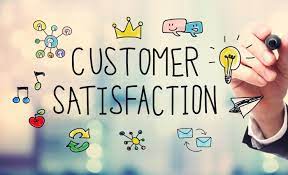Measure customer satisfaction
How customers view a business is significantly based on their experiences with it and their own personal outcomes. Customer interactions with an online business, whether directly or indirectly, can affect if they choose to return in the future. That’s why it’s important for e-commerce businesses to constantly assess customer satisfaction.
Measuring customer satisfaction involves conducting research to determine the performance of products or services based on how they are perceived by customers. The benefit of measuring customer satisfaction is that it can help a business gain profit and competitive advantage. The following are steps on how to measure customer satisfaction.
1. Define goals
Before a business can begin to measure customer satisfaction, it must define what to improve. There are many steps to a buyer’s experience with an online store, including: selecting the item they want to purchase, the checkout process, and the item delivery. Each of these steps has the potential for something to go wrong, so it’s important to be specific when thinking about what research goal.
In an earlier course, you learned that goals should be specific, measurable, attainable, relevant, and time-bound. Keep this in mind as you develop your goals.
Examples of goals are:
- Reduce redundancies and customer friction.
- Provide self-service options.
- Replace the sales rep with e-commerce customer service agents.
- Take customer reviews seriously.
- Resolve issues quickly.
- Resolve an issue in one interaction.
- Ensure customer service representatives are friendly.
- Being able to follow-up with the same person if necessary.
- Being able to record, print, and save a copy of the interaction.
- Follow up with customers afterwards to ensure they’re satisfied.
2. Choose a customer satisfaction survey type
As mentioned previously in a video, there are many types of customer surveys to gain insight to how customers feel about a business. The following are some common types of customer surveys.
Customer Satisfaction (CSAT) Survey
Customer Satisfaction surveys—or CSAT surveys—are used to measure a customer’s satisfaction with products or services. To review the variety of customer satisfaction surveys, check out a previous video on customer survey.
Net Promoter ScoreⓇ (NPS) Survey
Net Promoter Score Surveys are single question surveys that ask respondents to rate the likelihood that they would recommend a company, product, or a service to a friend or colleague on a scale from 0 for not at all likely to 10 for extremely likely. Unlike general CSAT surveys that are intended to measure customer satisfaction with a specific service or brand, NPS surveys are intended to measure the loyalty of customers to a company. The scores are broken into three categories:
- Promoters: responders with a score of 9 or 10. They are considered to be enthusiastic about the brand.
- Passives: responders with a score of 7 or 8. They are considered satisfied but not as enthusiastic enough to promote the brand.
- Detractors: responders with a score of 6 or less. They are considered to be unsatisfied and unlikely to shop with the business again.
To calculate a NPS score, businesses subtract the percentage of detractors from the percentage of promoters.
For example, if 15% are detractors and 60% are promoters, the overall NPS score is 45%.
Usability Survey
For e-commerce businesses, most of the purchase is done through the online store.
Usability surveys relate the customers’ satisfaction with the company’s website and identify any problems the customer may experience along their shopping journey.
3. Select a survey medium
Once you’ve selected a survey type, it’s time to select a survey medium. Different mediums can include:
- In-app or on-site surveys
- Post-service or post-purchase surveys
- Long email surveys
Once a business receives customer feedback, they can view how customers feel about their brand, services, or products. They can choose to implement the feedback based on trends in the data collected to make customers more pleased with future shopping experiences.
